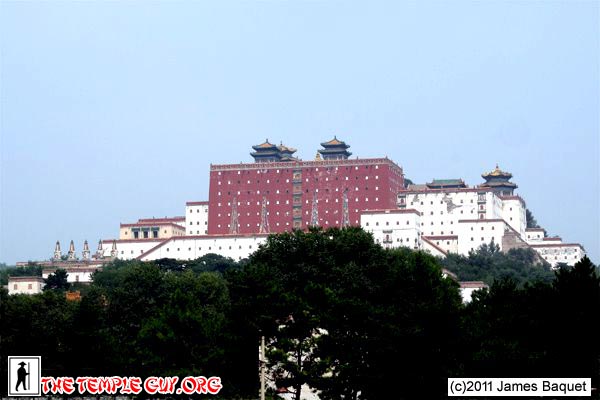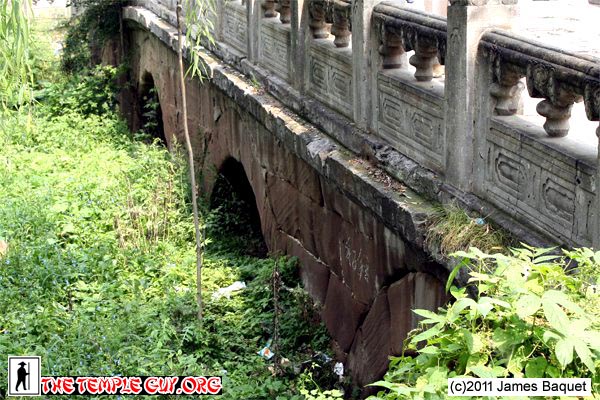(1) This morning I took a walk west of Puning Temple in Chengde, taking me past Shuxiang Temple, Putuozongcheng Temple, Xumifushou Temple, and then--closer to downtown Chengde--Yongyou Temple's pagoda.
First, a taxi to the far end, and the ruins of Luohan Temple. Ruins indeed: There's virtually nothing to see except a couple of old trees out front, and these retaining walls. I didn't dare go closer, as there's a military installation next door, and I didn't want to get shot--or worse, have my camera confiscated.
(2) Walking eastward, this is how my keen mind discovered that I shouldn't wander around. Somewhere near here are the ruins of another temple, Guang'an, but I decided not to go looking.
(3) This is Shuxiang Temple, Chengde, closed to the public. But I sat out front and said my prayers, writing a little poem in my head: "It doesn't matter if the temple is closed, if you have no desire to go in." How Zen. (Note the caged lion; is that for his protection--or ours?)
(4) The view from my prayer spot in front of Shuxiang Temple. Not shown here is the looky-loo who hovered over me the whole time. He and his buddy were sitting nearby with their dogs, and he got up and came over as soon as I started. We exchanged pleasantries afterward: Me "Good morning" Him (perfectly) "Good morning" (then to his friend) "Good morning, shenme yisi?" which is Chinese for "What does 'good morning' mean?" I translated, they laughed, I left.
(5) Also on the road near Shuxiang Temple: the Birdman of Chengde, tending his flock.
(6) The whole roadway was lined with morning glories and...
(7) ...sunflowers. (This one's for Lila.)
(8) This grandiose pile is Putuozongcheng Temple, modeled after the Potala Palace in Lhasa. It's huge, but I had neither the time nor the inclination to go in. Puning Temple was so great yesterday, I didn't need any more.
(9) Another view of Putuozongcheng Temple's gigantic "Red Platform."
(10) I didn't go in to the next temple, Xumifushou Temple, either. But the bridge out front was very impressive. It's a five-arch stone bridge (not well-tended, so some aren't visible here) built in 1780, the fifth year of Emperor Qianlong.
(11) I know when this bridge at Xumifushou Temple was built because a big sign in the middle of it told me, and says that it is part of the area's UNESCO listing. It also keeps cars off the bridge.
(12) The front of Xumifushou Temple. The name "Xumi" is a transliteration of "Sumeru," the central mountain of the world in Hindu belief. (The other two syllables of the name mean "Happiness" and "Longevity.")
(13) Shortly after leaving the bridge at Xumifushou Temple, I hopped a bus into town. Along the way I spotted this pagoda, that I'd been seeing from a distance for several days. Turns out it's Yongyousi Pagoda inside the Summer Palace grounds; Lonely Planet says it "soars above the fragments of its vanished temple." I'd love to see the "fragments," but lacking time (and money), this look over the wall had to do.
(14) Near the Huidiji Gate of the Summer Palace in Chengde (south of the pagoda) I spotted this bus driver who had found a new use for the cargo hold.
(15) Let's get high! (Bus stop ad, Chengde)
(16) They couldn't decide on a name. (Central Chengde)
| ←Previous Site | Back to Trip 10 Introduction | Next Site → |
Last Updated August 6, 2019

















No comments:
Post a Comment